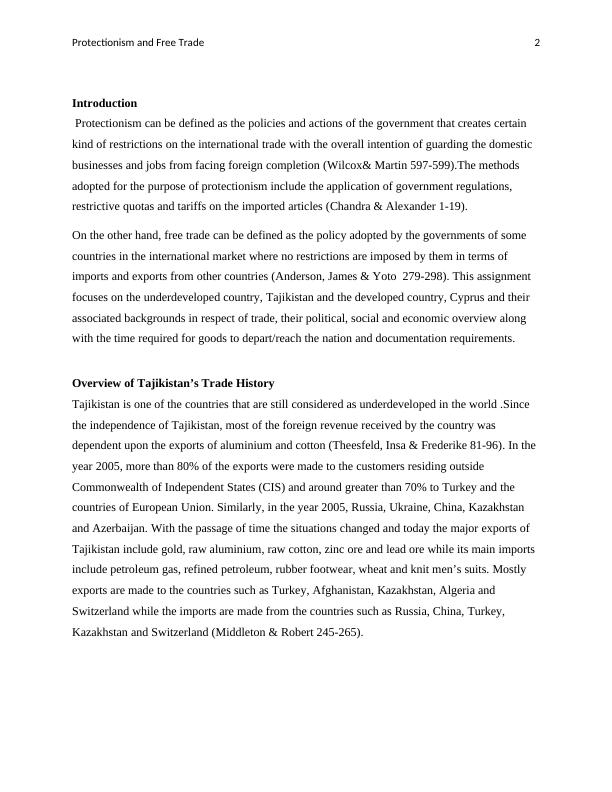Ask a question from expert
International Trade Assignment: Protectionism and Free Trade
13 Pages3877 Words70 Views
Added on 2020-05-28
International Trade Assignment: Protectionism and Free Trade
Added on 2020-05-28
BookmarkShareRelated Documents
RUNNING HEAD: Protectionism and Free TradeProtectionism andFree Trade

Protectionism and Free Trade 1ContentsIntroduction......................................................................................................................................2Overview of Tajikistan’s Trade History..........................................................................................2Social, Political and Economic Overview of Tajikistan..................................................................3Orography of Tajikistan...................................................................................................................4Infrastructures of Tajikistan.............................................................................................................4Export Value and Import Value.......................................................................................................5Departure From and Receipt of Goods at Tajikistan.......................................................................5Time Frame for Import/Export........................................................................................................5Transport Constraints.......................................................................................................................6Documentation for Import/Export...................................................................................................6Trade Facilitation Roadmap............................................................................................................7Priority in areas of improvement.....................................................................................................8Facilitation Trade Agreement between Tajikistan and Cyprus.......................................................9Conclusion.......................................................................................................................................9References......................................................................................................................................10

Protectionism and Free Trade 2Introduction Protectionism can be defined as the policies and actions of the government that creates certain kind of restrictions on the international trade with the overall intention of guarding the domestic businesses and jobs from facing foreign completion (Wilcox& Martin 597-599).The methods adopted for the purpose of protectionism include the application of government regulations, restrictive quotas and tariffs on the imported articles (Chandra & Alexander 1-19).On the other hand, free trade can be defined as the policy adopted by the governments of some countries in the international market where no restrictions are imposed by them in terms of imports and exports from other countries (Anderson, James & Yoto 279-298). This assignment focuses on the underdeveloped country, Tajikistan and the developed country, Cyprus and their associated backgrounds in respect of trade, their political, social and economic overview along with the time required for goods to depart/reach the nation and documentation requirements.Overview of Tajikistan’s Trade HistoryTajikistan is one of the countries that are still considered as underdeveloped in the world .Since the independence of Tajikistan, most of the foreign revenue received by the country was dependent upon the exports of aluminium and cotton (Theesfeld, Insa & Frederike 81-96). In the year 2005, more than 80% of the exports were made to the customers residing outside Commonwealth of Independent States (CIS) and around greater than 70% to Turkey and the countries of European Union. Similarly, in the year 2005, Russia, Ukraine, China, Kazakhstan and Azerbaijan. With the passage of time the situations changed and today the major exports of Tajikistan include gold, raw aluminium, raw cotton, zinc ore and lead ore while its main imports include petroleum gas, refined petroleum, rubber footwear, wheat and knit men’s suits. Mostly exports are made to the countries such as Turkey, Afghanistan, Kazakhstan, Algeria and Switzerland while the imports are made from the countries such as Russia, China, Turkey, Kazakhstan and Switzerland (Middleton & Robert 245-265).

Protectionism and Free Trade 3Social, Political and Economic Overview of TajikistanTajikistan is located in the heart of Central Asia surrounded by Kyrgyzstan, China, Afghanistan and Uzbekistan. The national identity of Tajikistan is influenced by various ethnic ties. Most of the population of Tajikistan shares the same language and kinship like the people residing northeastern Afghanistan. There exist cultural differences within Tajikistan as most of people areSunni Muslims, while some Iranians are Shiites. The people of Tajikistan are associated with the people and culture of Iran to a great extent since Persian and Tajik language are related to each other closely. Pamir Tajiks speak Shugni, Wakhi, Roshani, Ishkashimi, Khufi, Bartang and all other Iranian languages. Zeravshan River basin consists of another distinct group which is formed by descendants of ancient Sigdians and Yaghnabis. Tajik is recognized as the official language of the people in Tajikistan (Zafar & Athar 28).The economy of Tajikistan is dependent upon agriculture which provides employment to 2/5th of the labor force. The agriculture and industries suffered from the devastating impact after the civilwar which occurred after the independence of Tajikistan. The principle trading partners of the country include Turkey, China, Kazakhstan and Iran. The national currency is issued by the central bank. Tajikistan is rich in mineral deposits. The hydroelectric power sources are exploited with the help of mountain streams. Reserves of petroleum and natural gas and coal deposits are the energy resources of the country (Ito et. al. 692-707). The country is also engagedin the exportation of dried apricots, almonds and grapes (Coulibaly, Souleymane & Lotte 16-25).Tajikistan is a republic which consists of two of two legislative houses: Assembly of Representatives and the National Assembly. The legislature of the country is granted the authority to interpret the constitution, enact various laws and provide confirmation to the presidential appointees. The constitution of the country specifies various rights of the citizens along with the mechanisms with the help of which these rights can be restricted. The president ofTajikistan is appointed directly for tenure of maximum of two terms of five years (Hofman & Irna 1-21). The strengths of Tajikistan include its potential for significant hydroelectric power. Also, Tajikistan is rich in terms of raw material resources and financial support from countries like China. However, the foreign exchange reserves of the country are very weak. Moreover, the country is dependent upon the remittances derived from expatriate workers. Islamist terrorism

End of preview
Want to access all the pages? Upload your documents or become a member.
Related Documents
Bolivia’s Trade History Reportlg...
|11
|4156
|54